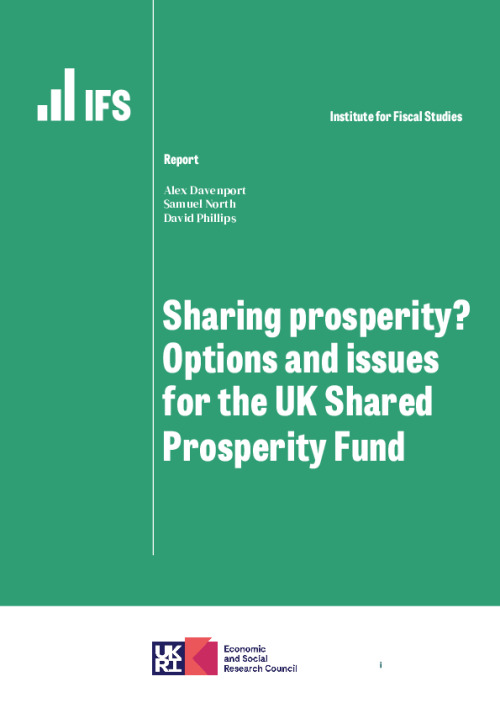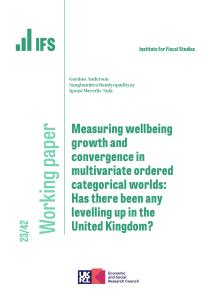European Structural and Investment (ESI) funds help to pay for initiatives supporting business development, research and development, investment in digital and green infrastructure, as well skills and training interventions and support for job-seekers. But with the UK having formally departed the European Union, the country will stop receiving new ESI funding at the end of 2020. Thus, for 2021 and beyond, the UK government faces choices over what to replace ESI funding with. This is important as ESI funding forms a substantial component of spending on regional economic development in the UK, especially in the poorest regions. The government has announced the creation of the UK Shared Prosperity Fund (UKSPF) to this end, but has so far given few details around its scale, design and implementation.
Drawing on a review of the current ESI schemes, this report explores some of the key issues that the government and stakeholders need to consider for the new system. It also looks at how the funding allocations for different parts of England will depend on the indicators of funding ‘need’ used to calculate UKSPF funding allocations. This shows that a focus on areas with low productivity would see several rural areas receive the highest levels of funding per person, while a focus on low education and employment, and especially high deprivation, would channel the most funding to more urban parts of the Midlands and the North. The report concludes with a brief discussion of the issues posed by the COVID-19 crisis for the design and implementation of the UKSPF.
Key findings
The current EU Structural Funding System
The UK is set to receive an average of €2.3 billion per year in ESI funding between 2014 and 2020, of which around two-thirds is for general economic development and one-third for agricultural innovation and rural development. The €1.6 billion – or €26 per person – of annual funding for general economic development is tiny in the context of overall UK government spending, but fairly sizeable compared with other funding streams. For example, spending in England is around 60% of what the government spends on its Local Growth Deals – which also cover housing and transport, as well as economic development and skills – and almost twice what is set to be spent on the Towns Fund, aimed at regenerating deprived towns.
Within the UK, funding allocations are heavily skewed towards the two poorest regions, reflecting EU-mandated funding ‘cliff edges’. Regions with economic output per person below 75% of the EU average are entitled to much more support than regions that are above this cut-off. As a result, Cornwall is due to receive an average of €144 per person per year between 2014 and 2020, compared to just €18 in South Yorkshire, which has only slightly higher output. These sharp differences are arbitrary, and a new UK system should avoid replicating them, while continuing a ‘progressive’ funding regime.
A new UK system should also be more transparent. As long as it respects the EU-mandated cliff edges, the UK government already has significant discretion to determine funding allocations for specific areas. Information on how it does this – including the role of formal formulae and informal judgement – is lacking though. However, it appears that the UK government has in recent years used its discretion to prioritise the Midlands and North of England relative to the South: for a given level of economic output per person, subregions in the Midlands and North receive two to four times as much as those in the South (other than Cornwall).
Complex EU rules restrict the use of ESI funds, limiting local discretion. Various minimum and maximum shares of funding need to go to projects satisfying certain ‘thematic objectives’, and projects must conform to centrally determined ‘investment priorities’ set out at the start of the EU’s seven-year funding period. This means that there is scope to make the new system less complex, more tailored to local priorities and more responsive to changing circumstances.
Research suggests ESI funding boosts economic growth in the areas receiving it. However, the impacts are larger in areas with better educated workforces and stronger governance. There could therefore be a trade-off between maximising the impact of funding and targeting it at areas with the greatest need – which are likely to include places with less-educated workforces and potentially weaker governance. Some studies find impacts largely fade following the cessation of funding, which suggests that an increased focus on the long-term drivers of productivity could also be worthwhile.
The design of the UK Shared Prosperity Fund
The government has highlighted boosting productivity and ‘tackling inequalities’ as two key objectives of the UKSPF – but detailed plans have yet to be published. This includes: information on the specific objectives of the scheme; the overall amount of funding available; how funding will be allocated between different parts of the UK and between different projects; and the rules on what funding can be spent on.
A key issue is the role of ‘needs’ versus ‘outcomes’ in funding decisions, and the extent to which competitive bidding is used. The current ESI funds use competitive bidding to select specific projects within regions, but funding for different regions is based on needs assessments. Extending the role of competition and outcomes assessment to regional allocations may be expected to channel more funding to the regions whose projects have the greatest potential or actual impacts, but the risk is that some poor regions miss out. However, evaluations of UK government programmes in the 1990s that used competitive bidding suggest that, on the one hand, the impact on project quality was limited, but that on the other hand the criteria used in assessing bids helped to ensure that poorer regions did not miss out on funding.
The geographic areas allocations are based on will be important. The government has indicated that funding in England could be allocated to Local Economic Partnerships (LEPs). These cover relatively large areas, which is likely to be appropriate if the focus of the UKSPF and any needs assessment is productivity. However, smaller geographies (and within-area inequalities) will be more appropriate if the focus is on deprivation and poor social outcomes, which are often more localised. For example, the South East LEP contains affluent London commuter areas such as Epping Forrest and Sevenoaks but also areas with significant deprivation and low levels of earnings such as the more distant Hastings, Thanet and Tendring.
It will also be important to consider how the UKSPF fits into a complex patchwork of place-based policies. These include city deals and local growth deals – which are funded via competitive bidding and do not have a specific focus on reducing geographic inequalities – and the Towns Fund – which combines a mix of needs-based funding and competitive bidding. If the rules and purposes of these different funds are not made clear and consistent, there is the potential for unnecessary complexity and inconsistent practice in different parts of the country.
What might needs-based funding allocations look like?
Deprivation, lack of qualifications and low employment are concentrated in urban areas of the Midlands and the North, but low pay and productivity are big issues for some rural areas too. The choice of indicators and the weights applied to them will therefore have significant impacts on how funding is distributed across the country.
Within England, for example, the (Welsh) Marches, Devon and Somerset, and Stoke and Staffordshire also have low productivity and pay, but perform better on other indicators. These areas could therefore do well from the UKSPF if productivity and pay are weighted highly, but much less well if deprivation, employment and qualifications are weighted highly.
Cornwall has the lowest levels of productivity and pay in England, but even if these were weighted highly in the new formula, it may still lose significant funding compared to now. This is because Cornwall’s very high allocation currently reflects the arbitrary cliff edges in the ESI system, which the new UKSPF should avoid replicating. Transitional arrangements should be considered to avoid another type of cliff edge though: a sudden reduction in funding to levels that other comparable regions receive.
Most urban and former industrial parts of the Midlands and the North score poorly across a range of indicators and will receive above-average funding irrespective of the specific weights applied to them. The Black Country stands out as an area that would be in the top three in terms of per person funding if either deprivation, education, employment, pay or productivity were used to allocate funding. The Tees Valley would be in the top four under the first four of these measures, but roughly mid-table if allocations were based on productivity alone.
The commitment in the Conservative manifesto to guarantee each UK nation at least as much funding as under existing EU schemes could mean similar areas in the different nations of the UK receiving very different amounts of funding. For example, West Wales and the Valleys and East Wales could receive much more than comparable areas of England, given the large allocations of EU funding they currently receive – which, in the former case, reflects the EU mandated ‘cliff edge’ and, in the latter case, political decisions by the UK government to shift funding from England to the devolved nations for the 2014–20 EU budgetary period.
What are the implications of the COVID-19 crisis?
The government has confirmed its intention to exit the EU transition period – and hence the ESI schemes – at the end of 2020. This means new UK arrangements will need to be in place before the end of year. If the pressing situation with the COVID-19 crisis means that it is impractical to finalise and consult on full details of the UKSPF, then the government could roll over existing allocations and rules for another year. This is the approach it has taken for local government funding in England, for example, where planned reforms to the funding regime from April 2021 have been postponed by at least one year.
The social and economic effects of the COVID-19 crisis could differ significantly between regions in ways not reflected in standard measures of regional and local economic disadvantage. For example, the share of employees in the hospitality sector varies between 4.5% in Redditch district and 25% in Weymouth and Portland district. Jobs linked to air travel are concentrated in the areas surrounding major airports such as Heathrow, Gatwick and Manchester, and aerospace manufacturing is especially concentrated in North East Wales and South Gloucestershire. Reliance on public transport – reductions in the capacity of which could significantly reduce commuter, shopper and tourist flows – is much higher in London and, to a lesser extent, other major cities. Moreover, such patterns are not strongly correlated with measures of productivity, skills, incomes and deprivation, which seem likely to be the basis for the allocation of the UKSPF.
A key decision is therefore whether to adapt the UKSPF so that one of its objectives is to support parts of the country that are struggling to recover from the COVID-19 crisis, or that potentially have other more targeted programmes and funding for this task. Integrating such support into the UKSPF could ensure that support for general economic development and recovery from the COVID-19 crisis is better integrated. However, it could complicate the operation and allocation of the UKSPF and it could mean that funding for recovery is not as well targeted as under a more bespoke scheme.










